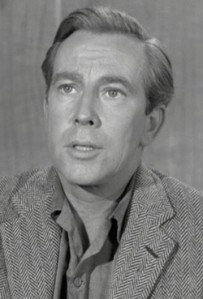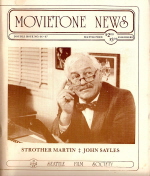 The longest and best-produced political campaign infomercial in TV history, Sarah Palin’s Alaska is (contrary to the avowed purpose of it) unabashedly in the service of promoting its star, the former governor of Alaska. You may well ask: promoting her for what? Nowhere during the first episode of the program does Palin state she is running for president (or anything else) in 2012. No, Palin is a good example of the modern phenomenon of free-floating candidacy, in which promotion of the self exists outside of a specific goal. It’s one of the many ways politics has merged with Hollywood, where a star can maintain a high profile and influence without actually appearing in any good or successful projects.
The longest and best-produced political campaign infomercial in TV history, Sarah Palin’s Alaska is (contrary to the avowed purpose of it) unabashedly in the service of promoting its star, the former governor of Alaska. You may well ask: promoting her for what? Nowhere during the first episode of the program does Palin state she is running for president (or anything else) in 2012. No, Palin is a good example of the modern phenomenon of free-floating candidacy, in which promotion of the self exists outside of a specific goal. It’s one of the many ways politics has merged with Hollywood, where a star can maintain a high profile and influence without actually appearing in any good or successful projects.
This is why her critics were so laughably wrong when they declared her career over on the day she awkwardly resigned from the governorship. Palin understands this stuff perfectly, and apparently intuitively. Having reached a certain level of prominence, the governing of a state became utterly irrelevant to the larger project—not just irrelevant, but a drain away from the big picture.
The surprising thing about Sarah Palin’s Alaska is that, even with this in mind, the first episode is barely underway before the political slaps arrive. Palin and her husband point out that writer Joe McGinniss has moved in next door and ruined their summer (filmed from afar sitting on his porch, McGinniss’s face is blurred out, as though he were a sexual predator on a reality crime show; this is done because he presumably didn’t sign a release form for the production company, but that’s not how it reads). Sarah doesn’t miss a chance to note that the fence extension her husband and his friends have built between properties is a metaphor for how we might keep out illegal immigrants. Or no, she doesn’t say this, quite; she says, “Others might look at it and say, ‘This is what we need on our nation’s border.'” Note the avoidance of owning this as her opinion and the use of a favored construction of political discourse: “Americans are tired of Obamacare and taxes on small business and Democrats who use infants in human sacrifice.” It’s not just my opinion—Americans factually feel these things, and the more times I say this, the more you are accustomed to accepting it as truth.
Now, it is true that throughout this show it is easy to observe the irony of Palin decrying the lack of privacy for her life (because of “kids” and “family,” inevitably) when she’s got a camera crew intruding on their world. Or the irony of her promoting herself as jes’ plain folks when she’s got a sea plane pulling up to her lakefront property and a camera studio in her backyard where she and hubby Todd prepare her Fox News appearances. (Todd: that mysterious, ravaged-voiced Fred Ward character, who comes across like Christian Bale’s assistant in The Prestige: he’s deliberately kept on camera just long enough so that you can’t quite form a picture of him.)
But wait. Apparently it’s not easy to observe that irony. Not for forty percent of the country, anyway. We’ve had a few decades now with irony and satire and sarcasm in the ascendency, and it hasn’t made a spot of difference to the forty percent that thinks Sarah Palin is a terrifically refreshing and feisty gal who represents family values while traveling around the country to soak up the spotlight and millions of dollars in fees (do all the kids travel with her all the time, or is the mama grizzly away from the den a whole lot)? Forty percent of the country does not see a contradiction in Palin’s energetic flaunting of her children and her schoolmarmy wrist-slappings toward those who would mention this reality, as when David Letterman made an actually quite funny joke that referred to her daughter’s out-of-wedlock pregnancy. But to understand such a joke would require an understanding of—all right, I’ll let it go.
The TV show has the kids, or some of them (it’s almost impossible to get a fix on how many of them there are), and Sarah going fishing near a bear enclave, and Sarah going rock-climbing. She reminds us that these rough Alaskan adventures, even if undertaken with expensive equipment and a full camera crew nearby, are the stuff of character-building, and we could all learn lessons from the wild. Yet they actually look like the actions of someone irresponsibly trying things they probably shouldn’t be doing without more preparation and training. In the political world, this means you end up looking glassy-eyed when Katie Couric asks you what newspapers you read; in nature, it means you end up dying alone in an abandoned bus in an Alaskan summer. The remarkable thing is that Palin has made advantages out of even her Couric moments. And however goofy or stomach-turning her TV series might be, there’s surely no downside in it for her. People know what they like, and they like this.
Addendum: Just watched Episode #2. All right, possibly some downside. Palin’s repeated descriptions of the dangers of live halibut inflicting bodily harm carry a faint echo of Jimmy Carter’s brush with a killer rabbit. Plus, after watching her enthusiastically club the fish to death, it is nerve-wracking to see her enter the proximity of whales and otters – nothing seems safe in the lady’s orbit. Strangely, though, as the show goes on the brief but frequent glimpses of Palin’s own fears and anxieties make you suspect that her loud saber-rattling is an enormous act of over-compensating.
Filed under: Culture Notes, The Cornfield | Tagged: Sarah Palin's Alaska | Leave a comment »















